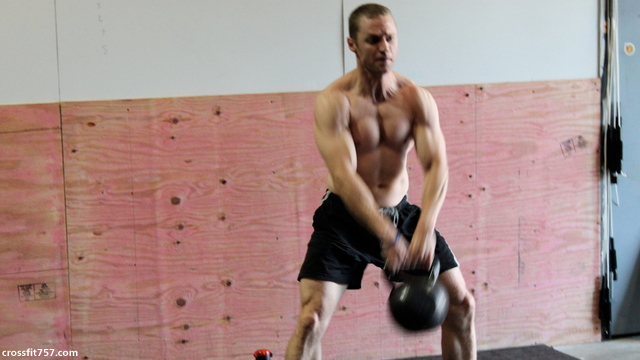Great Article
Carl Valle provides and interesting view point on Kettlebell Swings.
Valle's research articles to substantiate his position is good.
While I am a fan of Valle's SimpiFaster site and enjoyed this article, my perspective is not the same.
With that said, here's my rebuttal...
Kettlebell Load
The Kettlebell Swing is primarily a Power Movement; as are Olympic Movements.
Research has demonstrated that Power is optimally displayed with Olympic Movements with loads of 70 - 80% of a 1 Repetition Max.
Since Kettlebell Swings fall into the category of a Power Movement, that means a Heavy Kettlebell is required to display and develop Power.
That is one of the main issue with the most individual who preform Kettlebell Swings; they are not perform the movement that is heavy enough to optimize Power Development.
That issue is usually due to a lack of knowledge and the cost of a Heavy Kettlebell that has limited use; Heavy Swings or Deadlifts; it not usually heavy enough for Deadlifts.
With that in mind, let look what loads are most effective for...
Power Swings
...and many other movements.

scienceoftheswing.blogspot.com
This individual study indicates that a Kettlebell Load of approximately 30% of your body weight is essential for Power Development. That means a 180 lb individual would need to perform Kettlebell Swing with 60 lbs.
Heavy kettlebell swings could be the best damn posterior chain exercise you're not doing, possibly even better than deadlifts! Here's why.

www.t-nation.com
Contreras' EMG Study determined that Heavy Kettlebell Swings with Kettlebell Loads that were up to around body weight, produce Maximum Power Output. That means if you weighed 200 lbs, performing Swings with close to 200 lb Kettlebell.
| Style | Load (lbs) | Peak Vertical Force (N) | Peak Horizontal Force (N) |
| Squat Style | 70 | 2,170-2,349 | 166-182 |
| Squat Style | 140 | 2,431-2,444 | 278-353 |
| Hip Hinge Style | 70 | 1,935-2,140 | 340-402 |
| Hip Hinge Style | 140 | 2,325-2,550 | 499-520 |
On a personal note, my heaviest Kettlebell Swings (Hungarian Core Blaster) have been with 175 lbs for 5 Reps at a body weight of 195 lbs.
There is a learning curve with Heavy Swings. Initially, the Kettlebell was swing me.
The key is as the Kettlebell swings forward, you need to lay back to counter the forward movement of the Kettlebell/Hungarian Core Blaster.
Olympic Movements Vs Kettlebell Swings
1) The Power Output displayed and developed in the Kettlebell Swing is very close to the Olympic Movements.
2) The Kettlebell is a simple movement to learn comparted to an Olympic Movement.
3) Kettlebell Swings develops greater Horizontal Force Production; more specific for Long Jumps.
4) Olympic Movements develop greater Vertical Force Production; more specific to Vertical Jumps.
With that in mind, Trap Bar Jumps produce approximately the same amount of Power Output as Olympic Movements.
Trap Bar Jumps are a simple movement, easier to learn.
5) A common error with the Kettlebell Swing is many individual throw their head back as the Bell ascends. Doing so hyperextend the lower back. That is why some individual complain about Kettlebell Swings hurting their lower back.
The key to maintaining a neutral spine in a Kettlebell Swing is "Neck Packing"; as the Bell ascends tuck your neck into your chest.
One method to keying "Neck Packing' is to bit down on your shirt.
Horizontal Power Development
The Kettebell Swing is a Horizontal Movement. Thus, it is more specific to Horizontal Movements: Sprinting, Long Jumps, etc.
It is also a great Deadlift Assistance Exercise in the top part of the movement; once the bar hits the knee area.
To finish the top end of a Heavy Barbell Deadlift, you need a lot of hip drive; you need to drive your butt to the bar to complete it. Hip Drive is what Kettlebell Swings are all about.
Del Monte, MJ, Opar, DA, Timmins, RG, Ross, JA, Keogh, JWL, and Lorenzen, C. Hamstring myoelectrical activity during three different kettlebell swing exercises. J Strength Cond Res 34(7): 1953-1958, 2020-Kettlebell exercises have become an increasingly popular form of resistance training and...

pubmed.ncbi.nlm.nih.gov
This is a great reference on the different muscle involvement in three different swings.
One of the keys that ensures long term progress in muscle groups is to change/vary exercises that work the same muscle groups. As an example, if are performing a Wide Grip Bench Press, change it over to a Narrow Grip Bench Press.
The same muscle groups are worked but the workload is shifted more to from one muscle group to another.
This lead me to Contreras' article/chart listed above.
Hip Hinge Style Swing
This is the standard Kettlebell Swing. The emphasis of the work is on the Hamstrings and Glutes.
Squat Style Swing
Contreras EMG Chart demonstrates more of the workload in the Squat Style is shifted to Peak Vertical Force.
With the Squat Style, you sit back (Squat down) into the movement.
This places more of the workload on the Quads and Glutes, more so than the Hamstrings.
The Squat Style is a great method of teaching a Powerlifting Squat; where you sit back into movement.
Conditioning
Kettlebell Swing are a great "High Intensity Interval Resistance Training Method", HIIRT.
HIIRT is the Resistance Training Method of "High Intensity Interval Cardio Sprint Training".
The same protocol for the Resistance Method is used as the Cardio Sprint version.
High Intensity Interval Resistance Training and High Intensity Interval Cardio Sprint Training is Cluster Sets (EMOM, Every Minute On The Minute Training).
Research has demonstrated this type of training paradoxically increased anaerobic as well as anaerobic capacity. Most training only increase one; either aerobic or anaerobic, not both.
Hypertrophy Development
Dr Brad Shoenfeld's research determined optimally increasing muscle mass is dependent on three training factors.
The dominate factor is...
Metabolic Stress
In the world of Bodybuilding/Hypertrophy Training this is know as "The Pump/The Burn".
When higher repetition are performed two things occur...
1) Blood from the heart is pumped to the working muscles.
2) The muscle contraction restricts blood flow from the working muscle back to the heart.
What happens is blood is trapped in the muscles, which produce The Pump; the muscle balloons up.
Bodybuilding Rest Period are kept short, around 60 seconds or less.
This limits the amount of blood that is allowed to return to the heart. It allows you maintain more of The Pump and increase The Pump even more with each additional Set.
Secondly, The Burn in the muscles occurs due the build up of Lactate.
Lactate triggers a downstream, domino like effect. Growth hormone is released. Also, mTOR is triggered; which produces an anabolic, muscle building effect.
High Repetition/Moderately For Hypertrophy
This is the Hypertrophy Protocol.
This method also is effective for increasing muscle mass with the Kettlebell Swing in the Glutes and Hamstrings with the Hip Hinge Method or the Glutes and Quad with the Squat Style Method.



